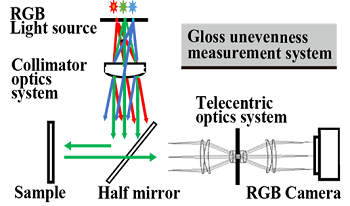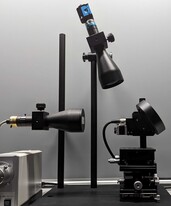
In this paper, we introduce the analysis for gloss unevenness by using developed multiple directional incident lights optics. Gloss unevenness is strongly related to recognition of material texture. However, it looks different depending on the angles, so it has been difficult to measure quantitatively. The gloss unevenness caused by surface roughness is able to analyze by the distribution of normal on the surface. We have developed the optical system that simultaneously illuminates with light from three different directions, angles, and captures images of gloss unevenness in one shot. We confirmed that the normal distribution of the surface can be estimated by analyzing the image. This proposed method can not only measure the gloss unevenness image, but also estimate the shape of the surface. As an application of this gloss unevenness observation technology, it is also possible to detect of scratches and coating unevenness in industrial quality control.

In this study, we introduced a measurement method for gloss unevenness as a function of reflectance angles. Gloss is one of the most important qualities of materials, and it is evaluated subjectively by the intensity of reflected light and gloss unevenness. People can estimate the texture of a material using gloss unevenness, which is found in the small peripheral part of the gloss area and can easily be recognized by observing the reflected light while moving the object or eyes. However, it is not easy to photograph and quantify gloss unevenness. One reason is the area where gloss unevenness is observed is a small area near specular reflection. Second, the appearance of gloss unevenness changes depending on the reflection angle. We developed a measurement apparatus to measure gonio-photometric gloss unevenness. We introduced two solutions: a wide-area gloss unevenness measurement technology using telecentric imaging and a rotating mirror optical system that defects reflected light at an angular resolution of 0.02°. We analyzed three materials—mirror, plastic, and paper—and proposed three indicators as a quantitative evaluation method for gloss: intensity of reflected light at the specular angle, full width at half maximum (FWHM) of Bidirectional Reflectance Distribution Function (BRDF), and gloss unevenness image at the FWHM.